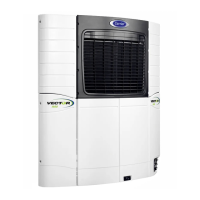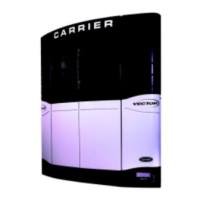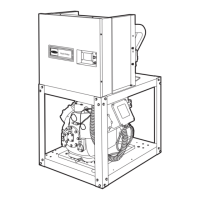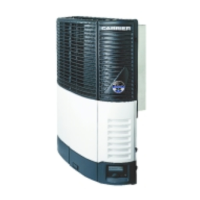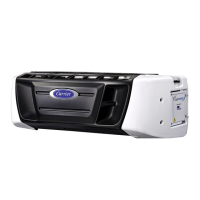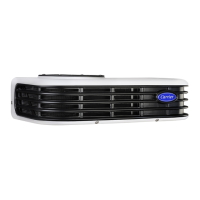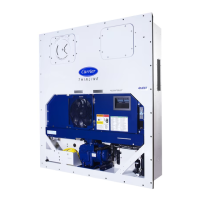Do you have a question about the Carrier VECTOR 6500 and is the answer not in the manual?
General safety guidelines for unit operation and maintenance.
Detailed hazard warnings and precautions for safe operation.
Identification and explanation of safety labels on the unit.
Overview of the Vector 6500 refrigeration unit's design and function.
Description of the engine-generator drive package and associated components.
Description of evaporator coil, fan, and related sensors.
Details on the Advance microprocessor, display, and keypad controls.
Explanation of system protection devices and their operation.
Procedure for starting the unit using the engine.
Procedure for starting the unit using standby power.
Detailed steps for performing the unit's pre-operation test sequence.
Explanation of the automatic engine cycling feature for efficiency.
Procedure for viewing currently active system alarms.
How to access and interpret system operating data.
Explanation of pre-programmed product settings for optimized operation.
Procedure for safely shutting down the unit.
Detailed explanation of unit operation modes.
How the system manages temperature based on sensor readings.
Logic and parameters governing automatic shutdown and restart.
Logic and parameters for non-stop operation.
Procedures and modes for managing defrost cycles.
How users can modify operating parameters.
Overview of different ways to interact with the microprocessor.
Procedures for accessing diagnostic and configuration modes.
Information on using PC cards for software and data management.
Step-by-step guide for replacing and configuring the microprocessor.
Guidance on using alarm lists and visual inspection for troubleshooting.
Troubleshooting steps for user-level alarms.
Troubleshooting steps for critical alarms that shut down the unit.
Troubleshooting steps for electrical system faults.
Troubleshooting steps for sensor-related issues.
Recommended maintenance schedule for optimal unit performance.
Procedures for conducting pre-trip inspections.
Procedures for servicing engine and related systems.
Procedures for servicing the refrigerant system.
Procedures for servicing the compressor and unloaders.
Service procedures for specific refrigerant system components.
Pinout diagrams for engine/off/standby harness plugs.
Pinout diagrams for start/run-off harness plugs.
Detailed wiring diagrams for the unit's electrical systems.
General safety guidelines for unit operation and maintenance.
Detailed hazard warnings and precautions for safe operation.
Identification and explanation of safety labels on the unit.
Overview of the Vector 6500 refrigeration unit's design and function.
Description of the engine-generator drive package and associated components.
Description of evaporator coil, fan, and related sensors.
Details on the Advance microprocessor, display, and keypad controls.
Explanation of system protection devices and their operation.
Procedure for starting the unit using the engine.
Procedure for starting the unit using standby power.
Detailed steps for performing the unit's pre-operation test sequence.
Explanation of the automatic engine cycling feature for efficiency.
Procedure for viewing currently active system alarms.
How to access and interpret system operating data.
Explanation of pre-programmed product settings for optimized operation.
Procedure for safely shutting down the unit.
Detailed explanation of unit operation modes.
How the system manages temperature based on sensor readings.
Logic and parameters governing automatic shutdown and restart.
Logic and parameters for non-stop operation.
Procedures and modes for managing defrost cycles.
How users can modify operating parameters.
Overview of different ways to interact with the microprocessor.
Procedures for accessing diagnostic and configuration modes.
Information on using PC cards for software and data management.
Step-by-step guide for replacing and configuring the microprocessor.
Guidance on using alarm lists and visual inspection for troubleshooting.
Troubleshooting steps for user-level alarms.
Troubleshooting steps for critical alarms that shut down the unit.
Troubleshooting steps for electrical system faults.
Troubleshooting steps for sensor-related issues.
Recommended maintenance schedule for optimal unit performance.
Procedures for conducting pre-trip inspections.
Procedures for servicing engine and related systems.
Procedures for servicing the refrigerant system.
Procedures for servicing the compressor and unloaders.
Service procedures for specific refrigerant system components.
Pinout diagrams for engine/off/standby harness plugs.
Pinout diagrams for start/run-off harness plugs.
Detailed wiring diagrams for the unit's electrical systems.
| Brand | Carrier |
|---|---|
| Model | VECTOR 6500 |
| Category | Refrigerator |
| Language | English |


